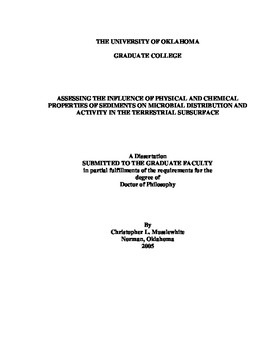| dc.contributor.advisor | McInerney, Michael J., | en_US |
| dc.contributor.author | Musslewhite, Christopher L. | en_US |
| dc.date.accessioned | 2013-08-16T12:19:55Z | |
| dc.date.available | 2013-08-16T12:19:55Z | |
| dc.date.issued | 2005 | en_US |
| dc.identifier.uri | https://hdl.handle.net/11244/925 | |
| dc.description.abstract | To maximize the possibility for success, accurate assessment of the distribution and activity of microorganisms in the subsurface is essential for implementing bioremediation strategies at contaminated sites. It is clear that large variations in microbial activity and abundance occur between strata with markedly different sedimentological features. However, the relationship between microbial activity and abundance and sedimentological properties within a single geological unit have not been quantified to the same extent as between strata. The central hypothesis driving this investigation was that the major controls of microbial activity in the subsurface are strongly correlated with a statistical description of the variation in the physical and chemical properties of the formation. To test this hypothesis, the relationships between sedimentological and microbiological parameters in the vadose zone of a barrier sediment and in a shallow, microaerophilic aquifer, both located on the eastern shore of Virginia, were examined. For the vadose zone sediment, pairs of samples were taken 10-cm apart in the vertical direction and 2 cm apart in the horizontal direction along three transects with one sample from each depth being processed aerobically and the other being processed anaerobically. Little variation was observed in the sedimentological and microbiological parameters tested. The sediment of all samples was fine to coarse sand with the grain sizes varying by less than an order of magnitude. Sediment moisture was low for all samples, but increased near the top and bottom of each sampling transect. These were regions where bioavailable Fe(III) concentrations were highest. Zero-order rates of H2 uptake were low throughout and ranged from below detection limit to 0.064 mumol H2 • day-1 • g -1 of sediment with a median rate of 0.01 mumol H2 • day-1 • g-1 of sediment. The variation in bacterial numbers was slightly more than an order of magnitude range over the entire sampling face. Phospholipid fatty acid analysis showed a diverse but fairly uniform microbial community from sample to sample. Statistical analysis revealed that the quartile of aerobically processed samples with the highest H2 uptake rates had statistically higher moisture content and bioavailable iron content than did the rest of the samples. The quartile of aerobically processed samples with the lowest H2 uptake rates had significantly more gravel, less moisture, and less bioavailable Fe(III) than did the rest of the samples. Similar trends were observed for anaerobically processed samples, but the differences were not significant. The data indicate that the spatial variation in microbial parameters is low within strata with uniform grain sizes. (Abstract shortened by UMI.) | en_US |
| dc.format.extent | xv, 81 leaves : | en_US |
| dc.subject | Biology, Microbiology. | en_US |
| dc.subject | Zone of aeration. | en_US |
| dc.subject | Microbial ecology. | en_US |
| dc.subject | Geology. | en_US |
| dc.subject | Engineering, Environmental. | en_US |
| dc.subject | Sediments (Geology) Microbiology. | en_US |
| dc.subject | Bioremediation. | en_US |
| dc.title | Assessing the influence of physical and chemical properties of sediments on microbial distribution and activity in the terrestrial subsurface. | en_US |
| dc.type | Thesis | en_US |
| dc.thesis.degree | Ph.D. | en_US |
| dc.thesis.degreeDiscipline | Department of Microbiology and Plant Biology | en_US |
| dc.note | Source: Dissertation Abstracts International, Volume: 66-12, Section: B, page: 6417. | en_US |
| dc.note | Adviser: Michael J. McInerney. | en_US |
| ou.identifier | (UMI)AAI3203285 | en_US |
| ou.group | College of Arts and Sciences::Department of Microbiology and Plant Biology | |
